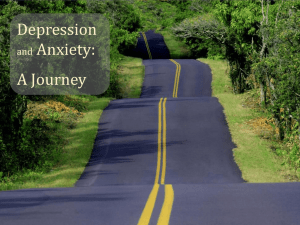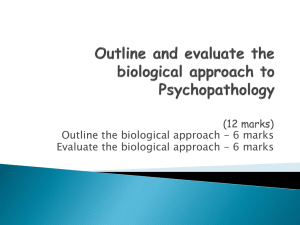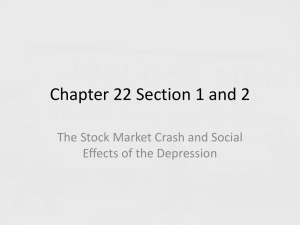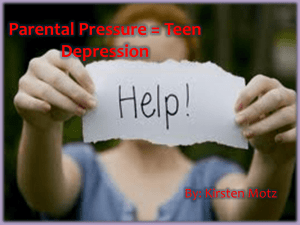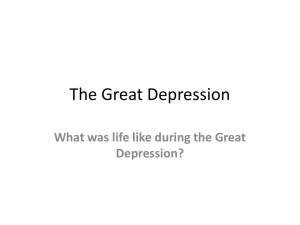Geriatric Psychiatry Lecture - SUNY Downstate Medical Center
advertisement
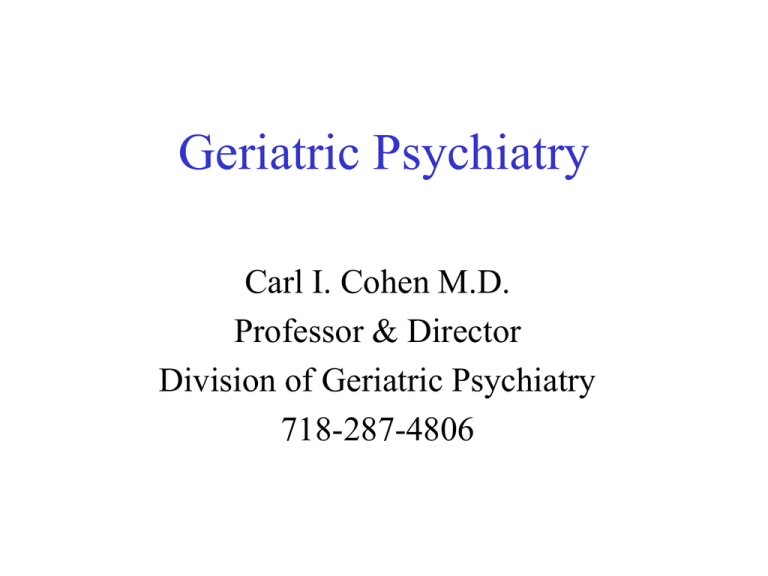
Geriatric Psychiatry Carl I. Cohen M.D. Professor & Director Division of Geriatric Psychiatry 718-287-4806 What are the differences between older and younger persons with mental illness? Assessment is different: e.g., cognitive assessment needed, recognize sensory impairments, allow more time Symptoms of disorders may be different: e.g., different symptoms in depression Treatment is different: e.g., different doses of meds, different psychotherapeutic approaches Outcome may be different: e.g., psychopathology in schizophrenia may improve with age DSM Disorders (in order of frequency) 12 -month prevalence Anxiety Disorders (phobic disorders,gen anx, panic) 6%-12% female>male Dementia 5-10% female>male Major depression 1-2% female>male Dysthymic disorder 2% female>male Alcohol abuse /dependence 1% male>female Schizophrenia 0.3 -0.5% Bipolar 0.3% Any DSM disorder 12% male=female male=female female>male OVERVIEW: Consider main syndrome & comorbid conditions Depression with Psychotic dementia depression (“pseudodementia”) Schizophrenia depression Vascular depression with depression with mild cognitive impairment MCI with depression psychosis Schizophrenia with cognitive deficits PDD, LBD, AD, VaD with psychotic sx med conditions & drugs dementia Dementia with depression PD with depression movement disorders Schizophrenia with movement disorders PDD, LBD, PD+ with cognitive deficits PDD, LBD, AD with movement sx SYMPTOM OVERLAP: OVERVIEW depression psychosis dementia movement disorders Depression is the most frequent cause of emotional suffering in later life and frequently diminishes quality of life. A key feature of depression in later life is COMORBIDITY--e.g., with physical illness such as stroke, myocardial infarcts, diabetes, and cognitive disorders (possibly bidirectional causality) Depressive symptoms are less frequent or no more frequent than in middle life. However, may be due to under-reporting , survivor effect, and case finding. Clinically significant depression in community dwelling elderly: 8% to 16%, with major depression being about 2%. The 1-year incidence of clinically significant depression is highest in those age 85+--13% Depressive mood disorders decrease with age but depressive symptoms are more frequent among the old-old(age 75+) but may be due to factors associated with aging such as higher proportion of women, more physical disability, more cognitive impairment , and lower income. When these factors are controlled , there is no relationship with age. Prevalence of depression among older persons in various settings: Medically and surgically hospitalized persons—major depression 1012% and an additional 23% experiencing significant depressive symptoms. Primary Care Physicians: 5-10% have major depression and another 15% have minor or subsyndromal depression. PCPs may not be aggressively identifying and treating depression Long-Term Care Facilities: 12% major depression , another 15% have minor depression. Only half were recognized. Approximately one-fourth of medically ill persons suffer from clinical depression! Major Depression Similar across lifespan but there may be some differences. Among older adults: •Psychomotor disturbances more prominent (either agitation or retardation), •Higher levels of melancholia(symptoms of noninteractiveness, psychological motor retardation or agitation, weight loss) •Tendency to talk more about bodily symptoms •Loss of interest is more common •Social withdrawal is more common •Irritability is more common •Somatization (emotional issues expressed through bodily complaints)is more common Emphasis should be: • less on dysphoria(depressed mood) and guilt • more on fatigue, sleep and appetite changes, vague GI complaints , somatic worries, memory or concentration problems, anxiety, irritability, apathy, withdrawal. DSM IV for major depression is problem because it essentially eliminates persons with any comorbid illnesses(i.e., excludes symptoms that are clearly due to “direct physiologic effects of general medical condition.”) Some investigators have suggested that older adults are more prone to “depression without sadness” or a depletion syndrome manifested by withdrawal, apathy, and lack of vigor. Depression in Clinical Population of Depressed Persons Aged 55+ FOLLOW-UP: 33 MONTHS MEDIAN B A S E L I N E Not Depressed(CESD <8)at follow-up (n = 40) Subclinical depression (CESD 8-15) at follow-up (n=37) Clinical depression(CESD> 16) at follow-up (n=66) Not depressed (CESD<8) at baseline (n=88) 38% 31% 32% Sub Syndromally depressed (CESD 8-15) at baseline (n = 30) 10% 30% 60% 16% 4% 80% Syndromally depressed (CESD>16) at baseline (n = 25) Treatment of Depression in Older Adults • Use same antidepressants as younger patients— however, start low, go slow, keep going higher, and allow more time(if some response has been achieved, may allow up to 10-14 weeks before switching meds). • Older patients may have a shorter interval to recurrence than younger patients. Thus, they may need longer maintenance of medication. • Data are not clear if the elderly are more prone to relapse. KEY TREATMENT STUDIES • 1. High risk older depressed pts(those with recurrent depression). Results:maintenance Rx with combination of meds & psychotherapy>meds alone >placebo. (Reynolds et al JAMA. 1999;281:39-45.) • 2 .Persons aged 70+ (mostly first episodes) who have responded to antidepressants, did better if maintained on medication(65% no recurrence) vs placebo(32% no recurrence) over 2 yrs. (note: psychotherapy didn’t provide additional protection in this study). (Reynolds et al, NEJM 2006; 354:1130-38) Value of Collaborative Care: THE IMPACT STUDY(Unutzer et al JAMA. 2002;288:2836-2845) 3. Rationale: Among primary care patients with depression, only a small fraction receives adequate treatment in primary care or sees a mental health specialist. Although treatment of depression in primary care has improved, few improvements deal with the specific needs of elderly patients. IMPACT STUDY: Care team consisted of a depression care manager (usually a primary care nurse), the patient's primary care doctor, a consulting psychiatrist, and a liaison primary care doctor. For 12 months, IMPACT patients received proactive depression treatment in primary care. Treatment options included pharmacotherapy, and two behavioral therapy approaches. Consulting psychiatrists saw about 10% of patients, typically treatment non-responders. RESULTS: 45% of intervention patients had a 50% or greater reduction in depressive symptoms from baseline compared with 19% of usual care participants. Antidepressants • Among antidepressants, citalopram, sertraline, venlafaxine, mirtazapine, buproprion, and duloxetine have minimal drug-drug interactions. Paroxetine and fluoxetine have most. Try to avoid the latter two drugs with older persons. • Venlafaxine, duloxetine, fluxoxetine and buproprion are most activating, sertraline is slightly activating, citalopram is neutral, and paroxetine is mildly sedating, and mirtazapine and trazadone are very sedating. • Paroxetine may cause mild anti-cholinergic effects and mirtazapine causes more pronounced effects. • Mirtazapine(moderate) and trazadone(high) have higher rates of orthostatic hypotension. Risk of SSRIs 1. Possible increased risk of bleeding 2. Hyponatremia –SIADH 3. Osteoporosis Factors Possibly Associated with Reduced Antidepressant Response • • • • • • Older age(>75 yrs) Lesser severity Late onset(>60) First episode Anxious depression Executive dysfunction Treatment for Depression with Executive Dysfunction or Cognitive Dysfunction • Problem solving therapy more effective than supportive therapy (Alexopoulos et al, 2011). • Problem solving identifies problems central their lives and methods for selecting solutions and making concrete plans for problem solution • Donepezil given to MCI patients who had responded to antidepressant and maintained on antidepressant: less likely to progress to dementia but greater likelihood of depression recurrence (Reynolds et al, 2011) Psychotherapy Originally thought to be ineffective over 50, e.g., Freud Controlled trials indicated useful for: • Major and minor depression • Recurrent depression, especially with meds • Prevent depression after stroke • Good evidence for Cognitive Behavior Therapy, Reminiscence and Life Review, Interpersonal Therapy, Problem Solving, Psychodynamic, Dialectical Behavioral Therapy (as adjunct to meds), Bibliotherapy (mild types) (Frazier et al, 2005) Other Modalities 1. Exercise 2. Bright light(especially in nursing homes) 3. ECT 4. rTMS (not strong evidence) 5. Folate The elderly no longer has the highest rates of suicide—the 35-64 age group is now higher Suicide frequency is highest for older white males at 46/100,000. –4x more common in older white males than in the general population. Older African American females have lowest rate. Overall: Suicide rates for African Americans and Latino elders have been lower than whites, whereas rates among Japanese, Chinese, and Korean American elders are comparable to whites •Risk factors include depression(usually under- or untreated), hopelessness; family history of mood disorders; loneliness(especially widowers); access to handguns; insufficient social support; physical illness and/or disability; low income; experiencing stressful life events such as financial problems or interpersonal discord; previous attempts. •Firearms are now most common method; 2nd is drug ingestion. (Attempts are more lethal in elderly: 1 in 4 suicide attempts succeed vs 1 in 25 in younger adults) ***80% of persons who commit suicide consulted a physician in prior month; 40% within one week. Bereavement(loss of a love one through death) Grief (psychosocial reaction to any loss such as depression, anxiety, guilt, anger, etc) •Approximately 800,000 older Americans are widowed each year. •Acute grief: traumatic distress,separation distress, guilt/remorse,social withdrawal, preoccupation with images of dead person---approximately 6 months---leads to Integrated Grief as a background state (reestablish interests, accessibility of memories of deceased but not preoccupied,more positive emotions) •Prolonged (also termed “complicated,” “traumatic”) grief: instead of transition form acute to integrated grief person fails to accept the death, guilt persists, overlap with major depression and/or PTSD •Very highs levels of symptoms after 1 month—about two-fifths meet criteria for major depression; in one study, at one year, 16% met criteria for major depression. Thus, roughly between 10-20% of widows develop clinically significantly depression in the first year of bereavement . •The presence of any substantial symptoms of depression at 2 months after a loss was associated with a significant increased risk of continued problems with depressive spectrum disorders. Other risk factors include personal/family hx of depression, depression at time of loved one’s death,poor medical health, younger age of survivor “Fallacy of Misplaced Empathy” Inappropriate to dismiss signs of major depression as “normal” in patients despondent because of loss Normal grief reaction versus Major Depression Suggestive Symptoms • Guilt about things other actions taken at time of death • Thoughts of death other survivor feelings • Morbid preoccupation with worthlessness • Marked psychomotor retardation • Hallucinations other than transient voices or images of dead person • Prolonged & marked functional impairment SYMPTOM OVERLAP: OVERVIEW Depression with dementia (“pseudodementia”) depression psychosis dementia movement disorders •Pseudodementia—“depression with reversible dementia” syndrome: dementia develops during depressive episode but subsides after remission of depression. •Mild cognitive impairment in depression ranges from 25% to 50%, and cognitive impairment often persists 1 year after depression clears. Even if depression and cognitive problems clear, they may be prodromal for eventual irreversible dementia (40% on 3-year follow-up). Hx of depression, especially in later life, even without cognitive impairment, is risk for eventual dementia. Depression vs Dementia •Persons with depression: •Symptoms of shorter onset (weeks or months vs years); progress more rapidly •Family more aware of disabilities •Patient is more distressed by disability, •Says “I don’t know” to questions, and are more irritable and do not want to answer the question •Often history of depression; •No problems with agnosia or apraxia. OVERVIEW Depression with dementia (“pseudodementia”) depression psychosis Vascular depression dementia movement disorders Vascular depression (depression due to vascular lesions): more common in late-onset disease. Increasingly evident that cerebrovascular disease seemingly plays a role in depression beginning in late life. Cerebrovascular disease may predispose or perpetuate some geriatric depressive syndromes. Such patients seem more resistant to treatment. Supported by comorbidity of depression and vascular risk factors and the association of ischemic lesions to distinctive behavioral symptoms. Vascular lesions include periventricular hyperintensity, deep matter hyperintensity, and subcortical gray matter hyperintensity. Disruption of prefrontal systems may be responsible. Symptoms include greater levels of apathy, psychomotor retardation and disability, and less agitation,psychoses, family history of psychiatric illness, guilt, and insight versus other older depressed persons. Vascular Depression Hypothesis (Krishnan & McDonald, 1995;Sneed & Cuslng-Reimlieb, 2011) Risk Factors •Age •Hypertension •Hyperlipidemia •Smoking •Diabetes Artherosclerosis Deep white matter lesions ( vulnerability to late onset depression) Negative life events Poor social support Vascular depression with executive dysfunction Summary: Late-onset depression—look for this triad: Cognitive risk Apathy, motor retardation Cerebrovascular lesions & risk factors Consequences of Depression with Vascular Lesions • Refractoriness to medication • Longer time to recovery (months not weeks) • Propensity for cognitive decline and vascular dementia • Propensity for stroke OVERVIEW Depression with dementia (“pseudodementia”) depression Vascular depression MCI with depression psychosis dementia movement disorders Three older ladies were discussing the travails of getting older. One said, "Sometimes I catch myself with a jar of mayonnaise in my hand, in front of the refrigerator, and I can't remember whether I was taking it out or putting it away." The second lady said, "Yes, sometimes I find myself on the landing of the stairs, and I can't remember whether I was on my up, or on my way down." The third lady chimed in, "Well, I'm glad I don't have those problems. Knock on wood." With that, she rapped her knuckles on the table, then said, "That must be the door. I'll get it." “MA6” Mnemonic for Dementia Memory impairment; and one of the following four items: Apraxia Aphasia Agnosia Abstraction and other executive functioning plus Absence of clouding of consciousness Ability to function is impaired Most common outcome Prevalence: about 10% of those in aged 70-79 to nearly 20% aged 80-89 About 5 to 16% conversion per year Neuropsychiatric Symptoms of MCI (Lyketsos et al, 2002; Geda et al, 2008) Depression: 20% to 27% (1/4) Apathy: 15 to 19% (1/6) Irritability: 15 to 19% (1/6) Psychosis: 5% (1/20) Movement Disorders and MCI (Aarsland et al, 2009) 20% of PD patients have MCI (1/5) (twice normal group) Treatment of MCI • • • • 3-year study (Petersen et al, 2005, NEJM) Conversion to AD was 16% Vit E 2000 IU had no benefit Donepezil 10mg delayed progression in the 1st year but the donepezil group caught up to the placebo group in the 2nd and 3rd years. It was slightly more effective in APOE e4 allele than non-carriers. Meta-analysis: OR=0.75 of developing dementia OVERVIEW depression psychosis movement disorders Depression with dementia (“pseudodementia”) Vascular depression with mild cognitive impairment MCI with depression Dementia with dementia depression Depression of Alzheimer’s disease: In persons who meet criteria for AD and who have at 3 of the following: depressed mood, anhedonia, social isolation, poor appetitie, poor sleep, psychomotor changes, irritability, fatigue or anergia, feelings of worthlessness, and suicidal thoughts. Prevalence: about ¼ of AD patients OVERVIEW Depression with dementia (“pseudodementia”) depression Vascular depression with mild cognitive impairment MCI with depression psychosis dementia movement disorders Dementia with depression PD with depression Depression and Parkinson’s Disease • In Parkinson’s disease about 40-50% have depression; about 1/3 have anxiety disorder • Depression precedes motor dysfunction in 12 to 37% of PD patients OVERVIEW Depression with dementia (“pseudodementia”) depression Vascular depression with mild cognitive impairment MCI with depression psychosis dementia Dementia with depression PD with depression movement disorders PDD, LBD, PD+ with cognitive deficits PDD, LBD, AD with movement sx Causes of Dementia (and most defining features) Alzheimer’s disease 60-70% (insidious onset; memory deficits early; consistency in loss of various cognitive functions) Vascular 10-30% (sudden onset,stepwise; less consistency (“patchy”) in cognitive deficits) Mixed (AD + Vascular) 10% Lewy Body 10-25% (central feature: dementia & Need 2 of 3 core sx:parkinson sx; fluctuating cognition with variations in attention and alertness; visual hallucinations) also milder cognitive deficits; falls; visuospatial deficits;neuroleptic sensitivity; REM sleep behavior Depression 5-15% 6. Frontotemporal 5-10% : executive or language (semantic/primary progressive aphasia) prominent early; memory less impaired early in disorder. Three types of cellular inclusions: a. Tar-DNA binding protein of 43kDa (TDP-43) --most common b. Tau c. Fused in sarcoma (FUS) protein Both Tau and TDP are associated with diverse pathologic subtypes including CBD, Pick’s, PNP ALS,PD types and semantic dementia 7. Other 10-20% e.g. Parkinson’s disease (movement disorder early--1-yr before dementia) Causes of Dementia by Neuropathology • Neurodegenerative syndromes E.g. AD, FTD, LBD,PD • Vascular syndromes E.g, infarcts, vasculitis, Binswanger • Nondegenerative, non-vascular E.g., TBI, infections, substance induced, metabolic syndromes Early Symptoms of 3 Dementias Memory Impairment Psychotic Parkinsx sonism Impulsivity Personality change +++ + 0 0 + LBD ++ +++ +++ 0 + FTD + + 0 +++ AD +++ Causes of Dementia by Neuropathology • Neurodegenerative syndromes E.g. AD, FTD, LBD,PD • Vascular syndromes E.g, infarcts, vasculitis, Binswanger • Nondegenerative, non-vascular E.g., TBI, infections, substance induced, metabolic syndromes Dementia & Parkinsonian Features: Distinguishing Characteristics Clinical Features PDD LBD AD with PD Initial sx parkinsonism parkinsonism, visual hall., cognitive fluctuations cognitive deficits Onset of cognitive decline late early initial Onset of psychiatric sx late early variable Severity of parkinsonism severe moderate mild to moderate Resting tremor very frequent mod. frequent rarely Rigidity & bradykinesia always always frequent Myoclonus 0% 20% 30% Response to levodopa Rx 100% 70%??? 0% Response to neuroleptics Worsening of parkinsonism Severe worsening Worsening of parkinsonism Relationship Between Clinical Diagnoses and Neuropathology Clinical Diagnosis Neuropathology Non-demented None PD Nigral LB (3/4), AD/Nigral LB(1/4) PDD Nigral LB(1/4), DLB(2/5), AD/Nigral(1/3) DLB DLB/AD (85%), 15%(DLB) AD AD(92%) AD/EPS AD(1/2), AD/Nigral LB(1/2) Note: DLB pathology: α-synuclein cortical & nigral Galvin et al (2006) Overlap among Various Dementias •Pure AD and VaD may be rare. Pure PD Pure AD •AD is multifactorial. •Similar risk factors: cholesterol, APOE4, DM, HTN. •Vascular pathology may contribute to cholinergic abnormalities in both disorders(cholinesterase inhibitors may help with both). Pure LBD Pure VaD Vascular Dementia AD (often with EPS)(40 -65%), PDD(75%), LBD(60-90%) cholinergic deficits in cortex Key Elements of the New Diagnostic Criteria and Guidelines for Alzheimer’s Disease • Expansion of the conceptual framework of Alzheimer’s disease to include a “preclinical” stage characterized by signature biological changes (biomarkers) that occur years before any disruptions in memory, thinking or behavior can be detected. The new guidelines do not yet specify which biomarkers should be considered signatures of preclinical Alzheimer’s. • Everyone who eventually develops Alzheimer's experiences a stage of minimal but detectable impairment (Mild Cognitive Impairment), although it's not currently diagnosed in most people. However, not everyone with MCI eventually develops Alzheimer’s, because MCI may also occur for other reasons. • • • • Model of the clinical trajectory of Alzheimer’s disease (AD) Hypothetical model of dynamic biomarkers of the AD expanded to explicate the preclinical phase Postulated temporal lag of approximately a decade between the deposition of Ab (% of individuals with amyloid plaques in a large autopsy series) and the clinical syndrome of AD dementia (estimated prevalence from three epidemiological studies) Graphic representation of the proposed staging framework for preclinical AD Staging categories for preclinical AD research Stage Description Ab (PET or CSF) Markers of neuronal injury (tau, FDG, sMRI) Evidence of subtle cognitive change 1 Asymptomatic cerebral amyloidosis + - - 2 Asymptomati amyloidosis +“downstream neurodege neration + + - 3 Amyloidosis + neuronal injury + subtle cognitive/ behavioral decline + + + Abbreviations: AD, Alzheimer’s disease;Ab, amyloid beta peptide; PET, positron emission tomography; CSF, cerebrospinal fluid; FDG, fluorodeoxyglucose; sMRI, structural magnetic resonance imaging. MCI criteria incorporating biomarkers Ab(PET or CSF) Neuronal injury (tau, FDG, sMRI) Diagnostic category Biomarker probability of AD etiology MCI–core clinical criteria MCI–core Conflicting/indeter minant/untested clinical criteria Uninformative Conflicting/indeterminant/untested MCI due to AD Intermediate Positive Untested Untested Positive MCI due to AD—high likelihood Highest Positive Positive MCI— unlikely due to AD Lowest Negative Negative Abbreviations: AD, Alzheimer’s disease;Ab, amyloid beta peptide; PET, positron emission tomography; CSF, cerebrospinal fluid; FDG, fluorodeoxyglucose; sMRI, structural magnetic resonance imaging. OVERVIEW depression Depression with dementia (“pseudodementia”) Vascular depression with mild cognitive impairment MCI with depression Dementia with dementia depression psychosis PD with depression movement disorders Schizophrenia with movement disorders PDD, LBD, PD+ with cognitive deficits PDD, LBD, AD with movement sx Movement Disorders in Schizophrenia 1. Higher rates of EPS in older adults using antipsychotic medications—about 1/3 with low dose antipsychotics Caligiuri et al,1999 2. Tardive dyskinesia is about 6x higher after 1year than younger adults(29% vs 5%), and 63% after 3 years with conventional antipsychotic agents Jeste et al,1999 3. TD about 5% after one year with atypical agents in elderly OVERVIEW Depression with dementia (“pseudodementia”) depression Vascular depression with mild cognitive impairment MCI with depression psychosis dementia Dementia with depression PD with depression movement PDD, LBD, AD, VaD with psychotic sx disorders Schizophrenia with movement disorders PDD, LBD, PD+ with cognitive deficits PDD, LBD, AD with movement sx Prevalence of Neuropsychiatric Symptoms(i.e., Psychiatric and Behavioral Problems) in AD Physical Aggression: 42% About half Verbal Aggression/threats: 54% Restlessness:38% Wandering: 29% Cause of caregiver distress Sleep disturbances:38% Apathy/Withdrawal: 27% Psychoses: Hallucinations:24% about half Delusions:50% Paranoia/suspiciousness:30% Emotional lability: 8% Mood disturbances(depression,tearfulness):29% About one-quarter Hallucinations in PD, DLB, PDD • ¼ Parkinson’s Disease • ½ Dementia Lewy Body • ¾ Parkinson’s Disease Dementia • In PD and PDD medications may contribute to psychotic sx Medication Principles •Use drugs only when behavioral approaches fail •Review current medications for effectiveness, side effects •Target symptoms •Select drugs based on target symptoms and side effect profiles •Monitor for side effects and potential drug interactions •Start low, go slow, but keep going. Use in conjunction with behavioral approaches •Give medications for adequate period of time •Educate patient and family about benefits and side effects •Periodically reassess medications –consider tapering or discontinuing Most commonly used +++ 0 NOTE: All atypical antipsychotics now carry warning about increased mortality rate. (Also seems to be true for older antipsychotic agents, e.g., Haldol.) Most deaths were due to cardiovascular and infectious(e.g, pneumonia) causes. Although death rates were 1.6 to 1.7 times greater than placebo, the absolute risk was about 2%--i.e., about 1 in 50 greater likelihood of death: 2.6% vs 4.5%) Effectiveness of atypical antipsychotic drugs in patients with Alzheimer's disease. Schneider LS et al NEJM 355:1325-1328,2006 In this 42-site, double-blind, placebo-controlled trial, 421 outpatients with Alzheimer's disease and psychosis, aggression, or agitation were randomly assigned to receive olanzapine (mean dose, 5.5 mg per day), quetiapine (mean dose, 56.5 mg per day), risperidone (mean dose, 1.0 mg per day), or placebo. Doses were adjusted as needed, and patients were followed for up to 36 weeks. The main outcomes were the time from initial treatment to the discontinuation of treatment for any reason and the number of patients with at least minimal improvement on the Clinical Global Impression of Change (CGIC) scale at 12 weeks. RESULTS: There were no significant differences among treatments with regard to the time to the discontinuation of treatment for any reason: olanzapine (median, 8.1 weeks), quetiapine (median, 5.3 weeks), risperidone (median, 7.4 weeks), and placebo (median, 8.0 weeks) (P=0.52). The median time to the discontinuation of treatment due to a lack of efficacy favored olanzapine (22.1 weeks) and risperidone (26.7 weeks) as compared with quetiapine (9.1 weeks) and placebo (9.0 weeks) (P=0.002). The time to the discontinuation of treatment due to adverse events or intolerability favored placebo. Overall, 24% of patients who received olanzapine, 16% of patients who received quetiapine, 18% of patients who received risperidone, and 5% of patients who received placebo discontinued their assigned treatment owing to intolerability (P=0.009). No significant differences were noted among the groups with regard to improvement on the CGIC scale. Improvement was observed in 32% of patients assigned to olanzapine, 26% of patients assigned to quetiapine, 29% of patients assigned to risperidone, and 21% of patients assigned to placebo (P=0.22). CONCLUSIONS: Adverse effects offset advantages in the efficacy of atypical antipsychotic drugs for the treatment of psychosis, aggression, or agitation in patients with Alzheimer's disease. Antidepressants • Among antidepressants, citalopram, sertraline, venlafaxine, mirtazapine, buproprion, and duloxetine have minimal drug-drug interactions. Paroxetine and fluoxetine have most. Try to avoid the latter two drugs with older persons. • Venlafaxine, duloxetine, fluxoxetine and buproprion are most activating, sertraline is slightly activating, citalopram is neutral, and paroxetine is mildly sedating, and mirtazapine and trazadone are very sedating. • Paroxetine may cause mild anti-cholinergic effects and mirtazapine causes more pronounced effects. • Mirtazapine(moderate) and trazadone(high) have higher rates of orthostatic hypotension. Cognitive Enhancers • Cholinesterase Inhibitors (donepezil,galantamine, rivastigmine ) may also help behavioral problems (mild effect) • Memantine (NMDA receptor antagonist) may also help behavioral symptoms(mild effect) Psychosocial Approaches •Behavioral oriented—e.g., breakdown behaviors into smaller components and addressing specific component •Emotion oriented—e.g., validation of emotional feelings, reminiscence therapy, supportive psychotherapy •Cognition oriented—e.g., reality orientation(to time and place), skills training, and other mind-stimulating activities •Stimulation oriented—activity, recreational, art and socialization groups (e.g., day programs) •Other non-specific interventions–e.g., reassurance, distraction, touch therapy, bright light therapy, exercise • Caregiver oriented interventions—e.g., support groups, education, respite care OVERVIEW Depression with dementia (“pseudodementia”) depression psychosis Schizophrenia with cognitive deficits PDD, LBD, AD, VaD with psychotic sx Vascular depression with mild cognitive impairment MCI with depression dementia Dementia with depression PD with depression movement disorders Schizophrenia with movement disorders PDD, LBD, PD+ with cognitive deficits PDD, LBD, AD with movement sx There is heterogeneity in outcome in schizophrenia into later life. Long-term studies observing the symptoms and functioning in early-onset schizophrenia suggest that the course of schizophrenia may not be as pessimistic as previously thought, and such findings challenge the notion implied in the term dementia praecox. Based on long-term studies carried out in Europe ranging from 22 to 37 years, Ciompi found: *20 to 27% of patients attained complete symptomatic remission, *22 to 33% attained mild end states, *24% to 29% attained intermediate end-states, *14 to 18% attained severe end-states. Thus, roughly half of persons exhibited recovery or mild end-states, and half showed moderate or severe end states. Symptom and Social Outcome in Schizophrenia Outcome Categories Trend with Age Comments Positive symptoms Improvement About half with mild or no symptoms Negative symptoms Possible improvement About half with mild or no symptoms Depressive symptoms Same or slightly worse Cognitive symptoms Slight worsening Adaptive Functioning Improvement About 1/3 no depression; 1/3 syndromal depression; 1/3 subsyndromal depression About half show only minimal or no cognitive impairment on standard tests About half with mild or no disability Quality of life Possible improvement Outcome Slight to considerable Most in “moderate” range, and much higher than persons with chronic pain. Only one-tenth in full recovery; half in symptomatic remission • Late-onset schizophrenia—onset after age 40 or 45(about 15-20% of all schizophrenia)--tends to occur disproportionately more in women, to have more persecutory delusions, fewer negative symptoms and formal thought disorders (see chart comparing early and late disorders) Characteristics Early-Onset Schizophrenia Late-Onset Schizophrenia Persecutory delusions + +++ Visual hallucinations + ++ Olfactory hallucinations + ++ Tactile hallucinations + ++ Thought disorder +++ + Affective blunting +++ + + ++ Sensory impairment Male –female ratio Medication dosage Male slightly higher high Women much higher low Summary of differences between early and late onset schizophrenia Comparison of Older Schizophrenic persons, Older Normal Persons, and Younger Schizophrenic Persons on DRS(controlling for education) –1988 study 140 135 Note: OS were significantly lower than ON on scales and 3-Dall Column 1 total DRS except attention scale 130 DRS score 125 120 115 110 Old Schiz Cohen et al., 1988 Old Normal Young Schiz OS was significantly lower than YS on construction and memory scales and total DRS. For older schizophrenic persons there appears to be a because cognitive deficits in young adulthood are followed by a“normal” decline due to aging. Thus, it can be concluded that even good outcome patients have persistent, but probably not progressive, cognitive and functional deficits in later life. •With respect to cognitive functioning, about ¾ of schizophrenic persons show cognitive dysfunction in the period after the onset of illness. •Of these, about 80%, have no further dramatic declines but show declines similar to other persons as they grow older. However, in later life this group remains cognitively impaired versus their normal age peers(equivalent to mild dementia). •The other 20% is more cognitively impaired and seems to show a marked worsening after age 65(equivalent to severe dementia). Measurement and Treatment to Improve Cognition in Schizophrenia(MATRICS)study Treatment Units for Neurocognition and Schizophrenia(TURNS) are now underway to examine various methods for assessing and enhancing cognition in schizophrenia Table. Comparison of psychosis in Alzheimer’s disease, older adults with Schizophrenia, and in Parkinson’s disease Psychosis of AD Schizophrenia Psychosis of PD Prevalence 35% to 50% 20% to 60% Basis for psychosis Non-cognitive manifestation of underlying pathology About 40 to 50% in nonacute states; nearly 100% in acute states Generally considered primary abnormality Bizarre or complex delusions Rare Frequent Rare Misidentification of caregivers Frequent Rare Rare Common form of hallucinations Visual Auditory Visual Schneiderian first rank symptoms Active suicidal ideation Rare Frequent Rare Rare Frequent Rare Past history of psychosis Rare Very Common (especially early-onset) Rare Eventual remission of psychosis Frequent About half Need for years of maintenance antipsychotics Uncommon Very common Often after adjustment of antiparkinsonian medication Uncommon 0.75mg to 1.5mg 2.5mg to 7.5mg 25mg to 200mg 1.5mg to 2.5mg 7.5mg to 12.5mg 50 mg to 300mg Sensory enhancement, structured activities, social contact, behavior therapy CBT, social skills training Usual optimal doses of meds: Risperidone Olanzapine Quetiapine Adjunctive treatment Usually antiparkinsonian drugs, but not always especially late stages Not recommended Not recommended 12.5 mg to 150mg (also Clozapine) Supportive therapy Schizophrenia vs AD Psychoses Treatment(dosage/length) 20% of young/short duration 50% of young/long duration OVERVIEW depression Schizophrenia with depression PDD, LBD, AD, VaD with psychotic sx Vascular depression with mild cognitive impairment MCI with depression dementia Dementia with depression psychosis Schizophrenia with cognitive deficits Depression with dementia (“pseudodementia”) movement disorders Schizophrenia with movement disorders PD with depression PDD, LBD, PD+ with cognitive deficits PDD, LBD, AD with movement sx Published studies in older adults • • • Three published studies from two research centers: San Diego & New York (Cohen et al, 1996; Jin et al, 2001; Zisook et al, 1999) Prevalence rates of clinical depression in the schizophrenic patients in these studies ranged from 11% to 56%. If mild/medium depression is included rates ranged from 44% to 75%. Found to be associated with severe functional impairment, presence of positive symptoms, physical limitations, younger age, lack of social support and lack of income Percentage of Persons in the Community and Schizophrenia Group Experiencing Various Levels of Depression Syndromal Depression: CES-D 16 (%) Subsyndromal No Depression: depression: CES-D = 8-15 CES-D < 8 (%) (%) Community Comparison Group (n=113) 11 19 71 Schizophrenia Group (n=198) 32 29 39 Note: χ2=31.36, df=2, p<.001 Note: More than three-fifths of older schizophrenic adults suffer from depression OVERVIEW Depression with dementia (“pseudodementia”) Psychotic depression depression Schizophrenia with depression Vascular depression with mild cognitive impairment MCI with depression psychosis Schizophrenia with cognitive deficits PDD, LBD, AD, VaD with psychotic sx dementia movement disorders Schizophrenia with movement disorders Dementia with depression PD with depression PDD, LBD, PD+ with cognitive deficits PDD, LBD, AD with movement sx Depression and Psychosis •Psychotic depression occurs in 20-45% of hospitalized elderly depressed patients and 15% of elderly depressives in the community. •Delusions are more commonly mood-congruent, including delusions of guilt, delusions of deserved punishment for moral or personal inadequacies, delusions of nihilism, somatic delusions, delusions of poverty. •Auditory hallucinations are less common and not easily described such as vague derogatory voices. •Catatonia in severe depressive episodes •Psychotic depression: ECT often most effective and fastest treatment. Alternative Rx: antipsychotic drug with antidepressant. Psychotic depression Schizophrenia with depression OVERVIEW depression med conditions psychosis & drugs Schizophrenia with cognitive deficits PDD, LBD, AD, VaD with psychotic sx Depression with dementia (“pseudodementia”) Vascular depression with mild cognitive impairment MCI with depression dementia Dementia with depression PD with depression movement disorders Schizophrenia with movement disorders PDD, LBD, PD+ with cognitive deficits PDD, LBD, AD with movement sx Medical Illness •Medical illnesses can cause psychosis with and without delirium. •DSM criteria require prominent hallucinations or delusions, with evidence from the history, physical examination, or laboratory findings that the disturbance is physiological consequence of the general medical condition. It should not be better accounted for by another mental disorder and does not occur exclusively during the course of a delirium. •Elderly persons are more at-risk because of high rates of physical illness, polypharmacy, and susceptibility to disruption of brain function. Medical causes of psychosis in older persons (“MINE”) Metabolic Vitamin B12 or folate deficiency, electrolyte abnormalities Infections Meningitis, encephalitis(e.g., herpes), syphilis, HIV/AIDS Neurological Parkinson’s disease,epilepsy, dubdural hematoma, stroke, Huntington’s disease (rare), tumor(rare) Thyroid disease, adrenal disease, hyper- or hypoglycemia Endocrine Adapted from Desai and Grossberg, 2003 Delirium •Perceptual disturbances are common; however, hallucinations also are frequent: Hallucinations: 40% to 67% Delusions: 25% to 50% •Psychotic symptoms are more commonly seen with hyperactive rather than hypoactive delirium •Visual > > auditory> other hallucinations •Paranoid delusions are the most common delusions •Clinical evaluation should help identify; dementia and delirium are often related Distinguishing Delirium from Dementia Onset/ etiology Duration/ course Attention span; Sensorium; cognition Psychomotor activity Mood Psychotic features delirium Sudden (hrs/ days; Usually immediate cause Usually short (days/ wks); fluctuating Decreased attention; impaired sensorium; Often several cognitive deficits Increased (1/3) or decreased (2/3) Normal to anxious Visual/ tactile;misinterpretations of visual stimuli dementia Insidious (mos to yrs); usually no immediate cause Usually slowly progressive over yrs; steady Normal attention; sensorium intact early stages; short-term memory early Usually normal to decreased Normal but apathy common Paranoid ideations, sometimes visual hallucinations Substance Induced Psychosis •Prevalence of substance use disorders in elderly persons: 2%-3% in women and 10% in men. •Psychotic symptoms may occur during alcohol (e.g., DTs), sedative, or barbiturate withdrawal, whereas stimulants (amphetamines, cocaine, OTC weight –reducing drugs) can cause symptoms with intoxication. •Opiates such as narcotic analgesics, heroin, codeine, and methadone may induce delirium, and consequently, psychoses. •Prescribed medications that are most common causes of psychosis are antiparkinsonian drugs, anticholinergic drugs, antiarrhythmic agents, corticosteroids. •If tactile hallucinations occur, consider drug withdrawal states, toxic, or metabolic disturbances. OVERVIEW Psychotic depression Schizophrenia with depression depression psychosis Schizophrenia with cognitive deficits PDD, LBD, AD, VaD with psychotic sx Depression with dementia (“pseudodementia”) med conditions & drugs Vascular depression with mild cognitive impairment MCI with depression dementia Dementia with depression PD with depression movement disorders Schizophrenia with movement disorders PDD, LBD, PD+ with cognitive deficits PDD, LBD, AD with movement sx Obtaining a good history is critical Psychoses Cognitive Impairment Depression Movement Disorder Recent Onset Primary Mental Illness: Depression (mood congruent delusions) Secondary to physical illness or drugs: Delirium Psychoses Depression Longer duration Primary Mental Illness: Schizophrenia (bizarre delusions, auditory hallucinations more common, psychoses precedes depression & any movement sx); Delusional disorder (circumscribed delusion; mild hallucinations, depressed mood secondary to delusions) Psychiatric sx are secondary: Alzheimer’s disease (dementia depression psychoses movement disorders); Lewy Body Dementia ( psychoses and dementia and movement disorder within 1 year) Parkinson’s Disease (movement disorder psychoses dementia Five “Ds” of Psychiatric Care in Older Adults Think of these possibilities and consider course: • Delirium: days to weeks • Drugs: days to months • Disease: days to months • Depression: weeks to months • Dementia: months to years Test yourself on Alzheimer’s disease(AD) and dementia—True or False? 1.Memory loss must always be present in dementia true 2. Depression is found in about ½ of AD patients false 3.About ½ of caregivers are clinically depressed true 4.About ¼ of AD patients suffer from comorbid illness that can impact on their cognitive status true 5.Antipsychotic agents are the initial treatment strategy for dementia false 6. Antipsychotic agents appear to pose no risk for use in AD patients false 7. LBD is characterized by visual hallucinations, EPS, and cognitive sx true Test yourself on depression and anxiety—true or false? 1. About one-fourth of community elders have depression false 2. Depressive symptoms are higher in persons aged 75+ true 3. About ¼ of medically ill persons suffer from depression true 4. Mortality rates are not greater among post MI pts with depression false 5.Social withdrawal is rare among older depressed pts false 6. Vascular depression is associated with apathy true 7. Highest rates of suicide are found among Asians and Latinos false 8. Anxiety and depression rarely occur together false Test yourself on schizophrenia-true or false? 1. About ¾ of schizophrenia begins before age 40 true true 2. Compared to early onset cases, persons with late-onset schizophrenia are more likely to have visual hallucinations, to be more paranoid, and to be women 3. Psychotic symptoms generally do not improve over the life false course of schizophrenic persons Congratulations—you are now an expert in geriatric psychiatry

